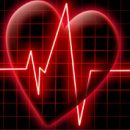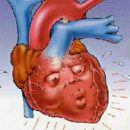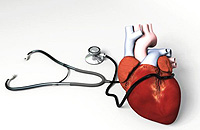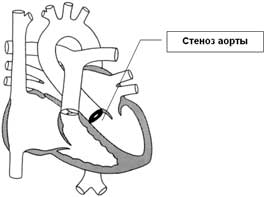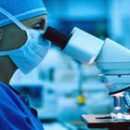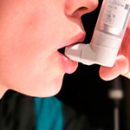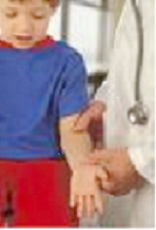Emergency assistance in angina must be as early as possible. What to do at the time of the attack of angina, how it manifests itself? Consider when you should seek emergency medical care and what to do before the doctor's arrival.
Content
Signs of the attack of angina
At the time of the attack of angina, a person has a feeling of pressure, gravity, mixed with a feeling of stupid pain, in the central part of the chest, behind the sternum, sometimes even somewhere deep in the throat.
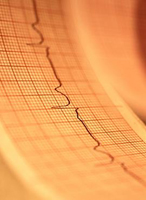
Under peace angina, often emerging at night or early in the morning, when the patient is in a state of complete rest, the factor of a vascular spasm (in one of the coronary artery sites) is of great importance. As a rule, such spasms appear in patients with arterial hypertension or affected by atherosclerosis coronary arteries.
It should be emphasized that the attack of the angina of each person with ischemic heart disease proceeds in its own way. One patient perceives them as a feeling of pain or burning, the other – as pressure or compression in the chest, the third – as a shortage of air, the inability to breathe freely. Differently told patients and about the pain zone during an attack: in some pain occurs in the left half of the chest with distribution in the left hand, in others – Pains are felt in the top of the sternum, less often they focus «Under the bow», In the upper belly, sometimes in the neck, lower jaw. Even in the same patient, angina attacks may differ from each other not only at the place of occurrence, but also by causing them factors, the time of appearance, frequency and duration.
There are periods when angina attacks appear occasionally, only in cold windy weather, if the patient is in a hurry to work and he has a difficult day. These periods can be changed by a deterioration in which these attacks occur every 150–200 meters of rapid walking; It forces the patient to stop and rest 2–3 minutes or taking nitroglycerin, after which the attack stops. In other cases, angina attacks have a certain relationship with excitement, nervous stress and accompanied by rapid heartbeat, lifting blood pressure. There are often such cases when previously disturbing attacks of angina rocks weaken or disappear on a fairly long period (weeks, months, sometimes years), patients are recovering. However, in the future, angina attacks are most often resumed. Thus, the manifestations of ischemic heart disease are extremely variable, and its course is characterized by changing the periods of the cloud and exacerbation.
In recent years, the term has been widespread «Unstable angina», which is opposed to stable angina. Stable angina – The condition characterized by the usual patient with the attacks of short-term prudged pains occurring under certain situations (with rapid walking, especially after eating, with excitement and t.D.). With a stable angina, a systematic planned treatment should be carried out, while in most cases there is no indication for urgent hospitalization. Another thing, if she arose for the first time in his life or her attacks frequent, if the angina of peace appeared along with the walls of the tension, the attacks became worse «Remove» nitroglycerin, became more sharp or longer. Angina of this type called unstable. Patients with unstable angina should dramatically restrict physical and emotional loads. Doctors carefully follow the state of their health and an electrocardiogram, in most cases such patients are hospitalized for intensive observation and active treatment in hospital conditions. The appearance of attacks by type of unstable angina may be precursor myocardial infarction.
As noted, it is not always easy to determine a clear line between angina and myocardial infarction. In some cases, a non-heightened myocardial infarction patients suffer «on foot», not resorting to medical care. However, more typically for infarction is a stormy and severe course in the initial period. Acute myocardial infarction most often proceeds as an attack of sharp, penetrating, protracted pain, or as a very painful feeling of squeezing the chest, as if someone squeezes her with visets. There are fright, anxiety, breathing makes it difficult, the patient is torn around the room, does not find a place. The excitement is replaced by weakness, cold sweat. Especially if the pain continues more than 1–2 hours.
What to do when attacking angina?
During such an attack, nitroglycerin, previously facilitated the state, almost does not reduce pain and gives only a short-term effect. And only a call to the ambulance doctor with the introduction of a patient of highly efficient drugs, take off attack. In the midst of pain pain becomes pale, pulse – weak and frequent, blood pressure drops sharply. This is the most dangerous period during the whole illness, requiring immediate intervention of the doctor and urgent hospitalization.
If a person first emerged a angina or an attack of chest pain, accompanied by weakness, cold, then, nausea and vomiting, dizzy or short-term loss of consciousness, it is extremely important to immediately call a doctor. Only a doctor is able to estimate the nature of certain manifestations of the disease and appoint additional studies that will allow to make an accurate diagnosis, to resolve the issue of the need for hospitalization and recommend proper treatment.
In all cases, the patient with suspicion of myocardial infarction is sent to the hospital, where it is carefully examined, observed and intensively treated. In specialized cardiology departments there are resuscitation chambers and blocks of intensive therapy, where it is placed in seriously ill, in order to establish permanent electrocardiological control and enhanced observation. In these chambers and branches, they cope with such complications of myocardial infarction, which are 10 more–15 years ago were considered incompatible with life.
 In some patients, myocardial infarction develops suddenly, almost without any precursors, with approving full health. However, if there is a survey of such «Healthy» People to myocardial infarction, in most cases you can find certain signs that testify about the atherosclerosis of the blood vessels or on the metabolic disorders that broke down long before the heart attack.
In some patients, myocardial infarction develops suddenly, almost without any precursors, with approving full health. However, if there is a survey of such «Healthy» People to myocardial infarction, in most cases you can find certain signs that testify about the atherosclerosis of the blood vessels or on the metabolic disorders that broke down long before the heart attack.
Install the diagnosis of myocardial infarction is sometimes difficult to recognize electrocardiography, the study of the biochemical composition of blood and other auxiliary diagnostic methods.
In many countries of the world, including in Russia, prophylactic surveys of the population are carried out to determine the hidden ischemic heart disease and underlying atherosclerosis of the coronary arteries, but so far such inspections are still everywhere. Unfortunately, not the entire population willingly respond to such events, although it is one of the direct ways to assess the state of health and timely adoption of measures to preserve.
The results of the treatment of ischemic heart disease, as well as assistance during angina, depend on the level of awareness of patients.
Need to adhere to a low fat diet, limit the admission of alcohol, abandon smoking, seek to reduce excess body weight, comply with adequate physical activity mode, avoid stress, learn how to remove emotional voltage.
The patient should know the possible equivalents of angina patient pain, learn to distinguish them from others. In an individual conversation, the attending physician gives a clear instructions of the patient about what cases the doctor's emergency doctor is needed, indicates the need to have self-help at hand, what funds and how to use them during angina.
Self-help techniques and consistent steps in the attack of angina
- If the pain occurs during exercise or while walking – immediately stop loads, stop and sit down.
- If the pain occurs alone, in the position lying – immediately sit down with lowered legs.
- Open the window, unbuttoning difficulty clothing, provide fresh air access.
- Take 1 nitroglycerin tablet under the tongue or bother under the nitromint dose. In the absence of the effect, this preparations are repeated (nitroglycerin in tablets with an interval of 3 minutes, nitromint after 1 minute) no more than 3 times. In the event of headaches for the reception of nitroglycerin, it is necessary to combine their reception with analgesics: Analgin, Baratgin, Sedalgin and others.
- If the pain lasts more than 20 minutes and the pain does not pass after a 3-h-nitroglycerin intake – Immediately call a doctor of emergency medical care, while before arrival ambulance to delab 0.25 g of acetylsalicylic acid (aspirin).
- At elevated arterial pressure – Inside or under the tongue of 0.15 mg of clofellin or other high-speed hypotensive drug in the required dose.
- When heartbeat more than 110 in 1 minute and absence of contraindications to take 10 – 20 mg of anapralline inside or under the tongue.
The patient should be aware that if the pain is accompanied by a sharp weakness, pallor, cold, then dizziness, these may be signs of decline in blood pressure and receiving nitroglycerin contraindicated. In these cases, you should lie, immediately call an ambulance doctor. To reduce pain, acetylsalicylic acid (aspirin) or tableted analgesics can be used:
Analgin, Baratgin and others.
Validol is not the main preparation of first aid and therefore its use can tighten the angina attack due to its weak efficiency.
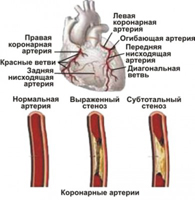 If the patient's attack is able to cope independently, it should restrict physical and emotional loads for the coming hours, adopt recommended for continuous treatment of drugs, compare it with previous attacks. After the attack of a angina, which was clearly different from ordinary (the pain arose for the first time alone or changed the localization or the spread of pain, or the pain is very strong and unusually long) or for the first time, it was necessary to call a doctor to the house and adopted a strict bed regime before it comes constant treatment of drugs, including 0.25 g of acetylsalicylic acid (aspirin). With frequent pulse, the reception can be useful to receive 40 drops of walkedordin or Corvalol.
If the patient's attack is able to cope independently, it should restrict physical and emotional loads for the coming hours, adopt recommended for continuous treatment of drugs, compare it with previous attacks. After the attack of a angina, which was clearly different from ordinary (the pain arose for the first time alone or changed the localization or the spread of pain, or the pain is very strong and unusually long) or for the first time, it was necessary to call a doctor to the house and adopted a strict bed regime before it comes constant treatment of drugs, including 0.25 g of acetylsalicylic acid (aspirin). With frequent pulse, the reception can be useful to receive 40 drops of walkedordin or Corvalol.

